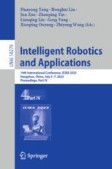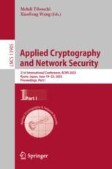Search
Search Results
-
SCIDP–Secure cloud-integrated data dissemination protocol for efficient reprogramming in internet of things
Base station (BS) offers data dissemination as a service to IoT smart devices, enabling efficient reprogramming or reconfiguration for their intended...

-
Reprogramming GANs via Input Noise Design
The goal of neural reprogramming is to alter the functionality of a fixed neural network just by preprocessing the input. In this work, we show that...
-
An Improved (Adversarial) Reprogramming Technique for Neural Networks
Neural networks can be repurposed via adversarial reprogramming to perform new tasks, which are different from the tasks they were originally trained...
-
Tight Adaptive Reprogramming in the QROM
The random oracle model (ROM) enjoys widespread popularity, mostly because it tends to allow for tight and conceptually simple proofs where provable...
-
Music Instrument Classification Reprogrammed
The performance of approaches to Music Instrument Classification, a popular task in Music Information Retrieval, is often impacted and limited by the...
-
Contrastive Fitness Learning: Reprogramming Protein Language Models for Low-N Learning of Protein Fitness Landscape
Machine learning (ML) is revolutionizing our ability to model the fitness landscape of protein sequences. Recently, the protein language model (pLM)...
-
Attribute inference privacy protection for pre-trained models
With the increasing popularity of machine learning (ML) in image processing, privacy concerns have emerged as a significant issue in deploying and...

-
Multi-material Integrated Printing of Reprogrammable Magnetically Actuated Soft Structure
The magnetically actuated soft structure has the unique advantages of remote actuation, free deformation, programmability, and high energy...
-
Sequential Reprogramming of Boolean Networks Made Practical
We address the sequential reprogramming of gene regulatory networks modelled as Boolean networks. We develop an attractor-based sequential...
-
Sequential Reprogramming of Biological Network Fate
A major challenge in precision medicine consists in finding the appropriate network rewiring to induce a particular reprogramming of the cell...
-
Selective Opening Security in the Quantum Random Oracle Model, Revisited
We prove that two variants of the Fujisaki-Okamoto transformations are selective opening (SO) secure against chosen-ciphertext attacks in the quantum...
-
Cabean 2.0: Efficient and Efficacious Control of Asynchronous Boolean Networks
We present a new version of the software, Cabean, integrating six source-target control methods and three target control methods for the...
-
Probabilistic Hash-and-Sign with Retry in the Quantum Random Oracle Model
A hash-and-sign signature based on a preimage-sampleable function (Gentry et al., STOC 2008) is secure in the quantum random oracle model if the...
-
Government Programming and Budgeting for AI Leaders
Program authorities and funding already exist for creating some impact on national security through AI. The President’s priorities and Congressional...
-
Cellular Reprogramming
With cellular reprogramming, it is possible to convert a cell from one phenotype to another without necessarily passing through a pluripotent state....
-
On the Quantum Security of HAWK
In this paper, we prove the quantum security of the signature scheme HAWK, proposed by Ducas, Postlethwaite, Pulles and van Woerden (ASIACRYPT 2022)....
-
A Detailed Analysis of Fiat-Shamir with Aborts
Lyubashevky’s signatures are based on the Fiat-Shamir with Aborts paradigm. It transforms an interactive identification protocol that has a...
-
Post-quantum Key-Blinding for Authentication in Anonymity Networks
Anonymity networks, such as the Tor network, are highly decentralized and make heavy use of ephemeral identities. Both of these characteristics run...
-
Shorter and Faster Identity-Based Signatures with Tight Security in the (Q)ROM from Lattices
We provide identity-based signature (IBS) schemes with tight security against adaptive adversaries, in the (classical or quantum) random oracle model...
-
Angriffssicherheit und Manipulationssicherheit bei KI-Systemen
Industrie 4.0 führt in der produzierenden Wirtschaft zu mehr Computertechnologie und mehr Vernetzung – intern und extern. Dabei treffen zwei Welten...
